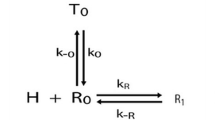Abstract
Here I summarize decades of work using the biophysics of class I MHC molecules to probe the patchiness and heterogeneity of cell surfaces. This program began as a study of membranes generally. MHC molecules were a convenient probe. However, in recent years, it has become clear that the lateral distribution, clustering, of class I MHC molecules in the membrane affects their recognition by effector CTL. This offers the possibility of enhancing or reducing T-cell recognition of targets by altering the clustering of their membrane proteins.





Similar content being viewed by others
References
Watkins JF, Grace DM. Studies on the surface antigens of interspecific mammalian cell heterokaryons. J Cell Sci. 1967;2:193–204.
Frye LD, Edidin M. The rapid intermixing of cell surface antigens after formation of mouse-human heterokaryons. J Cell Sci. 1970;7:319–35.
Jacobson K, Wu E, Poste G. Measurement of the translational mobility of concanavalin A in glycerol-saline solutions and on the cell surface by fluorescence recovery after photobleaching. Biochim Biophys Acta. 1976;433:215–22.
Schlessinger J, Koppel DE, Axelrod D, Jacobson K, Webb WW, Elson EL. Lateral transport on cell membranes: mobility of concanavalin A receptors on myoblasts. Proc Natl Acad Sci USA. 1976;73:2409–13.
Zagyansky Y, Edidin M. Lateral diffusion of concanavalin A receptors in the plasma membrane of mouse fibroblasts. Biochim Biophys Acta. 1976;433:209–14.
Edidin M, Zagyansky Y, Lardner TJ. Measurement of membrane protein lateraldiffusion in single cells. Science. 1976;191:466–8.
Wier M, Edidin M. Constraint of the translational diffusion of a membrane glycoprotein by its external domains. Science. 1988;242:412–4.
Yechiel E, Edidin M. Micrometer-scale domains in fibroblast plasma membranes. J Cell Biol. 1987;105:755–60.
Edidin M, Stroynowski I. Differences between the lateral organization of conventional and inositol phospholipid-anchored membrane proteins. A further definition of micrometer scale membrane domains. J Cell Biol. 1991;112:1143–50.
Edidin M, Zuniga M. Lateral diffusion of wild-type and mutant Ld antigens in L cells. J Cell Biol. 1984;99:2333–5.
Schnapp BJ, Gelles J, Sheetz MP. Nanometer-scale measurements using video light microscopy. Cell Motil Cytoskeleton. 1988;10:47–53.
Saxton MJ, Jacobson K. Single-particle tracking: applications to membrane dynamics. Annu Rev Biophys Biomol Struct. 1997;26:373–99.
Edidin M, Zuñiga MC, Sheetz MP. Truncation mutants define and locate cytoplasmic barriers to lateral mobility of membrane glycoproteins. Proc Natl Acad Sci USA. 1994;91:3378–82.
Capps GG, Pine S, Edidin M, Zuñiga MC. Short class I major histocompatibility complex cytoplasmic tails differing in charge detect arbiters of lateral diffusion in the plasma membrane. Biophys J. 2004;86:2896–909.
Engelman DM. Membranes are more mosaic than fluid. Nature. 2005;438:578–80.
Matko J, Bushkin Y, Wei T, Edidin M. Clustering of class I HLA molecules on the surfaces of activated and transformed human cells. J Immunol. 1994;152:3353–60.
Chakrabarti A, Matko J, Rahman NA, Barisas BG, Edidin M. Self-association of class I major histocompatibility complex molecules in liposome and cell surface membranes. Biochemistry. 1992;31:7182–9.
Edidin M. Near-field scanning optical microscopy, a siren call to biology. Traffic. 2001;2:797–803.
Hwang J, Gheber LA, Margolis L, Edidin M. Domains in cell plasma membranes investigated by near-field scanning optical microscopy. Biophys J. 1998;74:2184–90.
Tang Q, Edidin M. Vesicle trafficking and cell surface membrane patchiness. Biophys J. 2001;81:196–203.
Gheber LA, Edidin M. A model for membrane patchiness: lateral diffusion in the presence of barriers and vesicle traffic. Biophys J. 1999;77:3163–75.
Lavi Y, Edidin MA, Gheber LA. Dynamic patches of membrane proteins. Biophys J. 2007;93:L35–7.
McKeithan TW. Kinetic proofreading in T-cell receptor signal transduction. Proc Natl Acad Sci USA. 1995;92:5042–6.
San José E, Borroto A, Niedergang F, Alcover A, Alarcón B. Triggering the TCR complex causes the downregulation of nonengaged receptors by a signal transduction-dependent mechanism. Immunity. 2000;12:161–70.
Bachmann MF, Ohashi PS. The role of T-cell receptor dimerization in T-cell activation. Immunol Today. 1999;20:568–76.
Bodnár A, Bacsó Z, Jenei A, Jovin TM, Edidin M, Damjanovich S, et al. Class I HLA oligomerization at the surface of B cells is controlled by exogenous beta(2)-microglobulin: implications in activation of cytotoxic T lymphocytes. Int Immunol. 2003;15:331–9.
Edidin M. The state of lipid rafts: from model membranes to cells. Annu Rev Biophys Biomol Struct. 2003;32:257–83.
Kwik J, Boyle S, Fooksman D, Margolis L, Sheetz MP, Edidin M. Membrane cholesterol, lateral mobility, and the phosphatidylinositol 4, 5-bisphosphate-dependent organization of cell actin. Proc Natl Acad Sci USA. 2003;100:13964–9.
Fooksman DR, Grönvall GK, Tang Q, Edidin M. Clustering class I MHC modulates sensitivity of T cell recognition. J Immunol. 2006;176:6673–80.
Neumann F, Sturm C, Hulsmeyer M, Dauth N, Guillaume P, Luescher IF, et al. Fab antibodies capable of blocking T cells by competitive binding have the identical specificity but a higher affinity to the MHC-peptide-complex than the T cell receptor. Immunol Lett. 2009;125:86–92.
Hosseini BH, Louban I, Djandji D, Wabnitz GH, Deeg J, Bulbuc N, et al. Immune synapse formation determines interaction forces between T cells and antigen-presenting cells measured by atomic force microscopy. Proc Natl Acad Sci USA. 2009;106:17852–7.
Shen K, Thomas VK, Dustin ML, Kam LC. Micropatterning of costimulatory ligands enhances CD4+T cell function. Proc Natl Acad Sci USA. 2008;105:7791–6.
Lippincott-Schwartz J, Snapp E, Kenworthy A. Studying protein dynamics in living cells. Nat Rev Mol Cell Biol. 2001;2:444–56.
Kwik, JF. Immobilization of MHC class I molecules enhances allogeneic target cell lysis by CD8+T cells. Ph.D. Thesis, Johns Hopkins University; 2000.
Fooksman, DR. The surface organization of MHC class I molecules regulates their recognition by T-cells. Ph.D. Thesis, Johns Hopkins University; 2007.
Acknowledgments
This work was supported by NIH grant AI14584 to ME. My work in fluorescence microscopy was stimulated by the late Albert Coons, inventor of immunofluorescence and by a close colleague and friend, the late John Cebra. I am grateful to have been associated with them. I am also grateful to the many students and postdoctoral fellows who were involved in these experiments and to my longtime collaborators Martha Zuñiga and Michael Sheetz.
Author information
Authors and Affiliations
Corresponding author
Rights and permissions
About this article
Cite this article
Edidin, M. Class I MHC molecules as probes of membrane patchiness: from biophysical measurements to modulation of immune responses. Immunol Res 47, 265–272 (2010). https://doi.org/10.1007/s12026-009-8159-9
Published:
Issue Date:
DOI: https://doi.org/10.1007/s12026-009-8159-9




